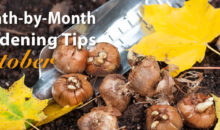How to Divide Perennials
We independently evaluate all recommended products and services. If you click on links we provide, we may receive compensation.
Many perennials can be divided to rejuvenate overgrown or decrepit plants, or to create new plants. Lifting and dividing plants is the perfect time to also replenish the soil with organic matter to encourage healthy growth and prevent disease.
Topics covered here include the following:
How to Tell if a Plant Needs Dividing
Each plant is different. Some need dividing every year, others every 2-3 years, and still others rarely or never need to be divided. Get to know your plants and you’ll be able to tell when to get out the spade. Also, look for the following signs that a plant needs dividing:
- the center of the plant dies out
- the plant is crowded in the center and starts to raise out of the ground
- the plant stops blooming or has dramatically fewer flowers
How to Divide Plants
Step 1. Dig the whole plant out of the ground, including as many roots as possible. Never try to dig out just part of the plant – you’ll end up damaging the rootball and probably killing the plant.
Step 2. Separate the plant into several pieces. Look for natural ‘breaks’ in the crown but, if there are none, don’t be afraid to simply separate the plant wherever you can. Use whichever means of separation works best – for example, tear it apart with your hands, use a sharp knife, saw, trowel, or spade to cut it apart, or pry it apart with two pitchforks placed back-to-back.
Step 3. During division, you will cut off some of the roots, causing the plant to wilt. To accommodate the smaller root system, cut back the foliage by about 1/3; the plant will need less water and nutrients to support the leaves and will rebound more quickly.
When to Divide Plants
One of the keys to successful division is knowing when to divide what. Most perennials can be divided at any time, provided they receive adequate care afterward. However, some prefer to be divided in spring or fall, while other perennials simply don’t respond well to division and are best left alone.
To help you achieve success with all of your plant divisions, here is a list of common perennials, along with when they should, or shouldn’t, be divided.
Divide these plants only in Fall
Arum (Arum italicum)
Foxtail lilies (Eremurus spp.)
Irises (Iris spp.)
Moss pink (Phlox subulata)
Peonies (Paeonia cvs.)
Poppies (Papaver spp.)
Siberian iris (Iris sibirica)
Sweet woodruff (Galium odoratum)
Do not divide these plants in Fall (divide them in the Spring)
Anemone (Anemone × hybrid)
Asters (Aster spp.)
Bleeding hearts (Dicentra spp.)
Monkshood (Aconitum napellus)
Wild ginger (Asarum europaeum)
Primroses (Primula spp.)
Rhubarb (Rheum palmatum)
These perennials are best not divided
Candytuft (Iberis sempervirens)
Carnation (Dianthus caryophyllus)
Delphinium (Delphinium × elatum)
Euphorbia (Euphorbia characias ssp. wulfenii)
Foxgloves (Digitalis spp.)
Garden sage (Salvia officinalis)
Geraniums (Pelargonium spp.)
Lavender cotton (Santolina chamaecyparissus)
Lavenders (Lavandula spp.)
Rose campion (Lychnis coronaria)
Rosemary (Rosmarinus officinalis)
Russian sage (Perovskia atriplicifolia)
Sea hollies (Eryngium spp.)
Silvermound (Artemisia schmidtiana)
Trillium (Trillium grandiflorum)
Tips About Dividing Perennials
● Divide while the plant still looks beautiful—don’t wait until the center has died out or the plant is overgrown.
● Plant smaller divisions– perennials grow quickly, as much as tripling in size in just one year.
● Spread the roots out horizontally when planting divisions—this means digging a wide planting hole.
Tools for Dividing Perennials
The best tool for the job depends on the size and type of plant you’re dividing.
For plants with tuberous roots, such as daylilies, a garden fork will be your best bet when digging up the plant. These types of plants don’t form compact rootballs; using a fork will let you gently dig up all of the tubers without a lot of soil. The plant can then be pulled apart, making sure that each section of the plant has both leaves and tubers.
Most perennials have fibrous roots that form a rootball around the plant (they may or may not send out longer roots, rhizomes, or stolons) which can be dug up using a sharp garden spade. Don’t worry about getting all of the roots; as long as you have a rootball (with soil) that’s about the same width as the plant itself, you should have plenty of roots to work with.
You have several options for dividing this kind of perennial:
- Cut the plant apart using a pruning saw, digging knife or hori hori, or even a kitchen carving knife (but be prepared to spend a lot of time sharpening it afterwards, or relegate it to the garden shed for use in future years).
- Separate the plant with a sharp spade. Simply put the plant on a level surface, place the flat edge of the spade against the crown of the plant where you want to divide it, and step on the spade. This will push the spade down through the crown and rootball, creating a new division.
- Use two garden forks placed back-to-back. Slide the forks into the center of the plant and then push the handles apart. This will tear the rootball in two with very little effort. This method is especially helpful when dividing ornamental grasses.





